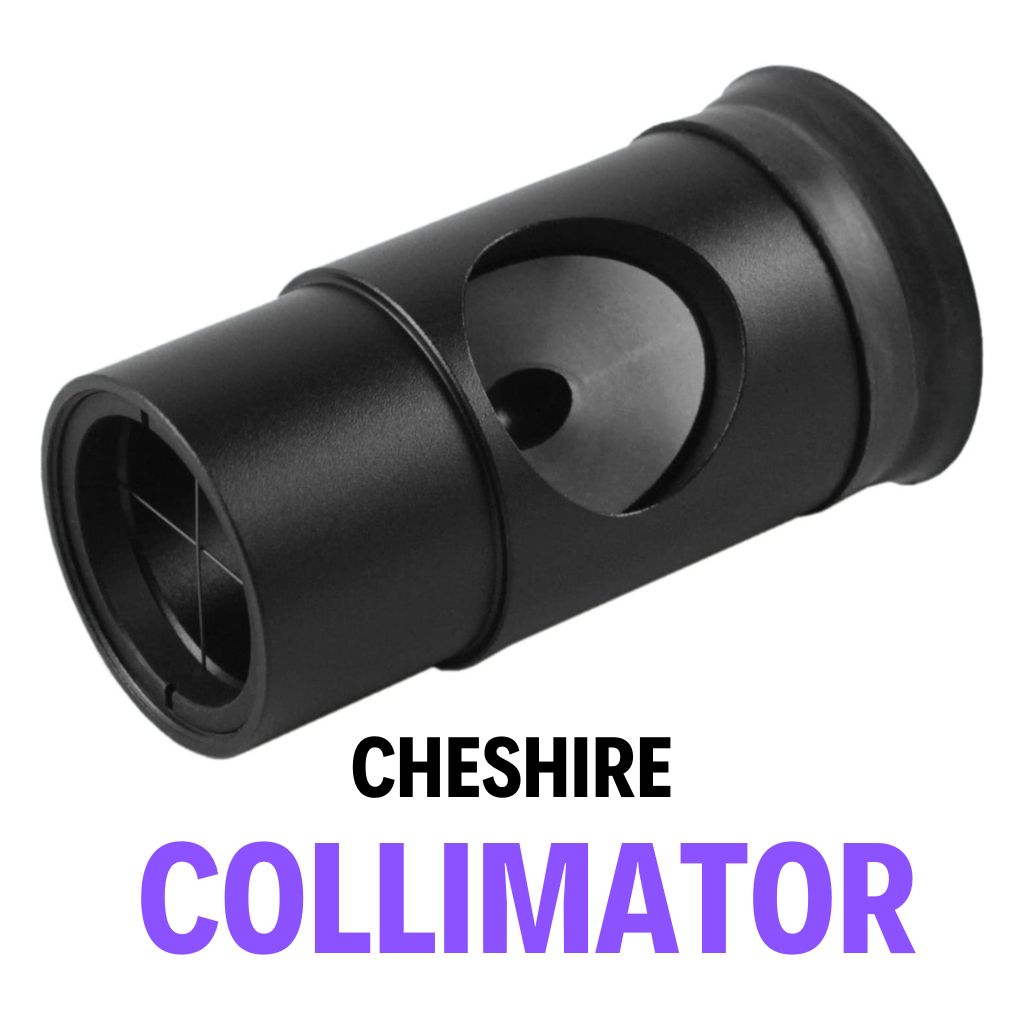This site contains affiliate links to products. I may receive a commission for purchases made through these links.
A Cheshire collimator is an eyepiece tool that is used for collimating a telescope, which means aligning its optical elements to achieve the best possible image quality.
The Cheshire collimator is particularly useful for collimating the secondary mirror in a reflecting telescope, which can be difficult to align without a specialized tool. It can also be used to align the primary mirror or lens elements in refracting telescopes.
Small faint circles in the telescope image can be caused by misaligned mirrors, which can be easily corrected using a Cheshire Collimator during setup.
Cheshire collimators come in various designs and sizes, but the basic principles of operation are the same. They are widely used by amateur astronomers for collimating their telescopes, as they are relatively inexpensive and easy to use.
Different models of the Cheshire collimator are available in the market, each with unique features and benefits.
In this article, we will provide an overview of the different models of the Cheshire collimator to help you make an informed decision on which one to use for your telescope.
Best Cheshire Collimators
Some Cheshire collimators stand out from the rest due to their exceptional quality and user-friendly design.
Let’s discuss some of the best Cheshire collimators currently available.
Farpoint reflective Cheshire collimator, 1.25″
The Farpoint reflective Cheshire collimator is an excellent choice for those looking for a high-quality collimator. It is designed to work with 1.25″ focusers and has a reflective peephole that provides a clear and bright view of the illuminated wire.
The collimator is made of high-quality materials and has a sturdy construction that ensures long-lasting performance.
Orion Cheshire collimator
The Orion Telescope Collimating Eyepiece is a type of Cheshire collimator designed specifically for aligning mirrors in reflecting telescopes. It is made by Orion Telescopes & Binoculars, a popular brand in the astronomy community.
The Orion collimating eyepiece is a simple and effective tool that can help you achieve precise alignment of your telescope’s mirrors for optimal viewing performance.
It consists of a black anodized aluminum tube with a peephole at one end and a reflective surface at the other end.
Celestron Cheshire collimator
The Celestron Collimation Eyepiece is a specialized tool designed for the precise collimation of Newtonian telescopes. It is a 1-1/4” eyepiece that can be fitted into any 1¼” focuser or diagonal.
The eyepiece is an essential tool for ensuring the mirrors in the telescope are properly aligned for optimal viewing.
The Celestron Collimation Eyepiece is very easy to use and provides a much more accurate alignment than a simple collimation tool.
With the help of the Celestron Collimation Eyepiece, users can achieve proper alignment of the telescope’s mirrors in no time. It is an indispensable tool for any serious astronomer who wants to get the most out of their telescope.
COLPARY 1.25Inch Metal Collimating Cheshire Eyepiece
The COLPARY 1.25Inch Metal Collimating Cheshire Eyepiece is a high-quality tool ideal for precise Newtonian collimation. Made from durable, anti-rust, and wear-resistant materials, this collimator ensures you can use it for a long time.
With its more accurate collimation than the normal collimation tool, this eyepiece can help you better enjoy the stars.
Astromania 1.25″ Cheshire Collimating Eyepiece
The Astromania 1.25Inch Metal Collimating Cheshire Eyepiece is a handy tool for aligning the optics of Newtonian reflectors, Dobsonian reflectors, and Schmidt-Cassegrain Telescopes (SCTs).
It fits in 1.25″ focusers and is easy to use; simply cap the telescope, remove the diagonal, and place the eyepiece directly in the focuser.
This short collimator for mirror (reflector) telescopes has a 45-degree plate for easier visual accuracy, and its aluminum construction makes it lightweight and durable.
A long version of the Astromania 1.25Inch Metal Collimating Cheshire Eyepiece is also available. This collimation eyepiece can precisely collimate the Newtonian and Schmidt-Cassegrain reflector telescopes, ensuring better image quality.
Svbony 1.25″ Cheshire Collimator
The SVBONY SV197 Collimating Cheshire Eyepiece is an essential tool for collimating your Newtonian and SCT reflector telescopes. It can also be used for accurately aligning refractor optics.
The SV197 eyepiece features a peephole at the top, allowing you to see the calibration result directly.
Precision machined from high-quality aluminum, this collimating eyepiece is durable and built to last. It features fine cross hairs and a clear, bright mirror with a sighting hole for easy alignment.
Alstar 1.25Inch Metal Collimating Cheshire Eyepiece
The Alstar 1.25Inch Metal Collimating Cheshire Eyepiece is a valuable tool for aligning the optics of Newtonian reflectors, Dobsonian reflectors, and Schmidt-Cassegrain Telescopes (SCTs).
Its design fits perfectly in 1.25″ focusers and is easy to use. Simply cap the telescope, remove the diagonal, and place the eyepiece directly in the focuser.
This long-version collimation eyepiece is made of high-quality aluminum, making it durable and resistant to wear and tear. The crosshair at the bottom allows for quick and precise centering of the optics.
DIY Cheshire Collimator
A DIY Cheshire Collimator can be made using basic tools and materials. To make a DIY Cheshire Collimator, you will need a tube (such as a piece of PVC pipe or an old eyepiece barrel), a drill, a file, a wire or crosshairs, and a peephole (which can be made by drilling a small hole in the tube and filing it to shape).
It involves creating a peephole at the end of a tube and inserting a wire or crosshairs that can be viewed through the peephole.
The wire or crosshairs should be positioned at the center of the tube, and the peephole should be located at the end of the tube opposite the wire. Once assembled, the collimator can be used to align your telescope’s optics.
A homemade Cheshire Collimator can be an inexpensive option for amateur astronomers who want to save money or enjoy building their own equipment.
How to use a Cheshire Collimator
Using a Cheshire collimator is a straightforward process that involves inserting the collimator into the telescope’s focuser and aligning the optics by adjusting the secondary and primary mirrors.
To use a Cheshire collimator, follow these steps:
- Insert the Cheshire collimator into the focuser and secure it in place.
- Look through the peephole and adjust the primary mirror so that it is centered in the view.
- Adjust the secondary mirror so that its reflection appears in the peephole and is centered in the view.
- Adjust the secondary mirror’s tilt and rotation until the reflection appears as a round circle or a centered crosshair.
- Repeat the process until the reflection appears perfectly aligned in the peephole.
Using a Cheshire Collimator when the Secondary mirror is Offset
When using a Cheshire collimator with a telescope that has an offset secondary mirror, the process is slightly different. In this case, do the following:
- Insert the Cheshire collimator into the focuser of the telescope.
- Adjust the secondary mirror until its reflection appears in the peephole of the Cheshire collimator.
- Adjust the tilt and rotation of the secondary mirror until its reflection appears as a centered circle or crosshair in the peephole.
- Adjust the primary mirror so that its reflection appears in the peephole and is centered in the view.
- Check the tilt and rotation of the secondary mirror again to ensure correct alignment.
- Make adjustments if necessary until the reflection appears perfectly aligned in the peephole.
Using a Cheshire Collimator when the primary mirror is off-center
- To check whether the primary mirror is off-center, place the Cheshire collimator in the focuser, and look through the eyepiece.
- If the reflection of the collimator is not centered in the secondary mirror, the primary mirror is likely off-center.
- You need to make small adjustments to the three mirror clips or screws holding the mirror in place to adjust the primary mirror.
- Use the Cheshire collimator to align the primary mirror by ensuring that the collimator’s reflection is centered in the secondary mirror.
You may also like: How To Collimate Mirrors On Newtonian Reflector
Tips for accurate alignment with a Cheshire Collimator
Here are some tips for achieving accurate alignment with a Cheshire collimator:
Clean your optics
Before using the Cheshire collimator, ensure your telescope optics are clean and free of dust or debris. This will help you get a more accurate alignment.
Adjust the secondary mirror
If you have a reflector telescope, adjust the secondary mirror to be centered on the focuser. This will make the collimation process easier.
Use a dark room or cover your primary mirror
When using a Cheshire collimator, it’s best to work in a dark room or cover the primary mirror to reduce external light interference. This will make it easier to see the collimation marks on the Cheshire.
Align the collimation marks
The goal of collimation is to align the collimation marks on the Cheshire collimator with the reflection of your telescope’s primary mirror. Take your time and make small adjustments until the marks are aligned.
Repeat the process
After making adjustments, double-check your alignment with the Cheshire collimator. Repeat the process until the collimation marks are perfectly aligned.
FAQs about Cheshire Collimator
Let’s address some frequently asked questions about Collimators to help you better understand how to use them and get the best results from your telescope.
What are the types of telescope collimators?
There are several telescope collimators, including the Cheshire collimator, laser collimator, and autocollimator.
Each type is designed to align different aspects of the telescope’s optics and requires different tools and techniques to use.
What is the main difference between a Cheshire and a cap?
The main difference between a Cheshire collimator and a cap is the way they align the optics of a telescope. A Cheshire collimator uses a wire or crosshair that is viewed through a peephole to align the secondary and primary mirrors of the telescope.
On the other hand, a collimation cap is a solid disk placed over the end of the telescope’s tube to align the secondary mirror with the focuser.
Does a Cheshire collimator have a cap on it?
A Cheshire collimator typically has a cap on one end with a small peephole in the center, and some models may have crosshairs on the other end.
The collimator is inserted into the focuser of the telescope and used to align the optics for collimation purposes. Cheshire eyepieces are considered a valuable tool for collimation work.
Laser collimator vs Cheshire eyepiece, which is better?
The choice between a laser collimator and a Cheshire collimator depends on personal preference and the type of telescope being used.
Laser collimators are generally more precise and easier to use, but they can be more expensive. Cheshire collimators are more affordable and can be used with a wider range of telescopes, but they require more skill to use effectively.
The Cheshire eyepiece is more suitable for aligning the secondary mirror, while the Laser collimator is better for aligning the primary mirror.
Is using a Cheshire collimator on a Schmidt Cassegrain easy?
Using a Cheshire collimator on a Schmidt Cassegrain telescope can be more challenging than on other types of telescopes. The design of the SCT’s optical system can make it difficult to align the mirrors properly.
However, with practice and patience, using a Cheshire collimator on an SCT can be done successfully.
How do I use the Cheshire collimator on a refractor?
The Cheshire Collimator is an essential tool for aligning the mirrors in a reflecting telescope tube to ensure optimal performance.
To use a Cheshire collimator on a refractor telescope, insert the collimator into the focuser and follow the same alignment process as for other types of telescopes.
The primary mirror will be replaced with the objective lens, and the secondary mirrors will not be present.
When using a refractor telescope cell with fixed cell objectives, it’s important to use a Cheshire Collimator to align the mirrors for the best image quality.
What is the best Cheshire collimator for SCT telescopes?
The best Cheshire collimator for SCT telescopes will depend on personal preference and budget.
Some popular options include
- Farpoint reflective Cheshire collimator
- Orion Telescope Collimating Eyepiece
- SVBONY SV197 Collimating Cheshire Eyepiece
What is a good 1.25″ Cheshire collimator with a crosshair sight tube?
Some popular options for a good 1.25″ Cheshire collimator with a crosshair sight tube include
Takeaway: Cheshire Collimator eyepiece is a must-have tool for precision alignment
The Cheshire collimator is a simple but effective tool for aligning a telescope’s optics. Various Cheshire collimator models are available on the market, each with its own features and specifications.
Observing under ambient light can make aligning the mirrors in a telescope more challenging, but a Cheshire Collimator makes the process easier and more precise.
With the right Cheshire collimator and a bit of practice, you can achieve optimal alignment of your telescope’s optics and enhance your stargazing experience.
You may also like:




